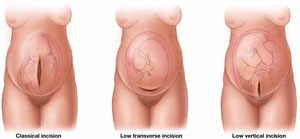On balance, any cesarean delivery imparts an increased risk of maternal morbidity and mortality, compared with vaginal delivery, as well as an increased risk of complications, such as placenta previa and placenta accreta, in subsequent pregnancies.
What are the risks of a trial of labor?
A prospective, 4-year observational study conducted at 19 academic medical centers under the auspices of the National Institute of Child Health and Human Development Maternal-Fetal Medicine Units Network compared the outcomes of 17,898 women undergoing a trial of labor after cesarean delivery with those of 15,801 women having elective repeat cesarean.2 Symptomatic uterine rupture occurred in 0.7% of the women attempting a trial of labor, with no occurrences in the elective cesarean group. Blood transfusion and endomyometritis were more common in the group undergoing a trial of labor, and this difference was statistically significant. These findings are in concordance with those of earlier studies.
The two groups in this study were not exactly the same; more women undergoing a trial of labor had had a previous vaginal delivery. Significant adverse maternal outcomes, such as endomyometritis, uterine rupture, hysterectomy, and the need for transfusion, were much more likely in a failed trial of labor than in a successful one.
The same study found a 0.46% risk of hypoxic-ischemic encephalopathy, which was most likely to occur after symptomatic uterine rupture (7 of 12 cases). No cases of hypoxic-ischemic encephalopathy occurred among women undergoing planned cesarean delivery. Multivariate logistic regression analysis determined that the risks of stillbirth, neonatal death, and hypoxic-ischemic encephalopathy in term infants were increased in the group undergoing a trial of labor, compared with elective repeat cesarean (odds ratio [OR], 2.72; 95% confidence interval [CI], 1.49–4.97).
Can we predict the success of a trial of labor?
Combined success rates from a large number of prospective cohort studies suggest an overall rate of 75.9%. Many clinical characteristics may increase the likelihood of success of a trial of labor after cesarean. In this section, I describe these characteristics and sift the data we have about them.
A history of vaginal delivery ups the odds of success
Women who have delivered vaginally have a much lower risk of rupture during a trial of labor after cesarean than women who have not. Women who have delivered vaginally are also four times more likely to have a successful VBAC. A multicenter, prospective study found a VBAC success rate of 86% among women who had already delivered vaginally, and a success rate of 90% among women who had a history of successful VBAC.3
Many aspects of the cesarean delivery have continuing impact
The type of labor that occurred in the cesarean delivery may help predict subsequent complications and the ultimate success of a trial of labor. For example, induced labor or no labor prior to cesarean delivery is associated with a 2.25-fold risk of uterine rupture in a subsequent trial of labor, compared with a history of spontaneous labor.4
In addition, several studies have demonstrated that the indication for the first cesarean delivery has a bearing on the success of a subsequent trial of labor. For example, an indication of shoulder dystocia reduces the success rate of a subsequent trial of labor by one third.2
Even a brief trial of labor before the cesarean may increase the success of a subsequent trial of labor. One study found that cervical dilation to 8 cm or greater was independently predictive of successful VBAC among women who had a nonrecurring indication for the initial cesarean delivery.5
When the cesarean delivery involves a preterm infant, the risk of uterine rupture during a subsequent trial of labor may increase if the infant is at term. Conversely, the risk of uterine rupture is lower when a term cesarean is followed by a preterm trial of labor.6
A vertical hysterotomy may preclude VBAC
A previous classical hysterotomy is generally an absolute contraindication for a trial of labor because rupture may occur in as many as 14% of women who have this type of scar.
Low transverse hysterotomy does not appear to confer excess risk during a subsequent trial of labor. Less clear is whether a low vertical hysterotomy poses a risk of rupture. In a 2004 prospective cohort study, the rate of uterine rupture among women who had a transverse hysterotomy scar was 0.7%, compared with 2.0% for a low vertical scar. Any difference in the rate of uterine rupture in retrospective studies may be attributable, at least in part, to the subjective nature of the definition of “low vertical” because there is no precise or objective way to ensure that the vertical hysterotomy did not breach the contractile portion of the uterus (FIGURE).


